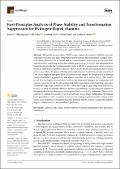| dc.description.abstract | Thermally grown oxide (TGO) layers—primarily alumina (Al2O3)—provide
oxidation resistance and high-temperature protection for thermal barrier coatings. How-
ever, during their service in humid and hot environments, water vapor accelerates TGO
degradation by stabilizing metastable alumina phases (e.g., θ-Al2O3) and inhibiting their
transformation to the thermodynamically stable α-Al2O3, a phenomenon which has been
shown in numerous experimental studies. However, the microscopic mechanisms by which
water vapor affects the phase stability and transformation of alumina remain unresolved.
This study employs first-principles calculations to investigate hydrogen’s role in altering
vacancy formation, aggregation, and atomic migration in θ- and α-Al2O3. The results
reveal that hydrogen incorporation reduces the formation energies for aluminum and
oxygen vacancies by up to 40%, promoting defect generation and clustering; increases
aluminum migration barriers by 25–30% while lowering oxygen migration barriers by
15–20%, creating asymmetric diffusion kinetics; and stabilizes oxygen-deficient sublattices,
disrupting the structural reorganization required for θ- to α-Al2O3 transitions. These effects
collectively sustain metastable θ-Al2O3 growth and delay phase stabilization. By linking
hydrogen-induced defect dynamics to macroscopic coating degradation, this work provides
atomic-scale insights for designing moisture-resistant thermal barrier coatings through the
targeted inhibition of vacancy-mediated pathways. | ru_RU |
